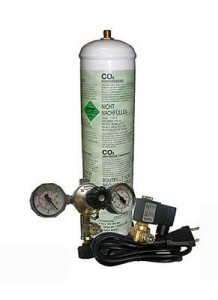When you are going to be using CO2 enrichment, you will need to know how to measure the levels of CO2 for everything to work properly. Monitoring CO2 levels in grow rooms helps to keep levels consistent though at times it can be rather expensive.
Disposable CO2 test kits are easy to use, accurate, and inexpensive. a disposable test kit contains a syringe, and test tubes and sells for around $15 – $30.
For this disposable kit to work, you will first break off each end tip of the test tube, insert the closed syringe into one then pull the syringe back and you will see the inside color of the syringe change to blue.
This is because the active ingredients react with the CO2 in the air that is drawn through the cylinder and these kits are often reliable to within 40 parts per million (PPM). Another type of CO2 testing system is an electrochemical sensing system that measures the electrical conductivity of an air sample; this is done by either an alkali solution or distilled or de-ionized water.
These systems are a little more expensive than disposable CO2 testing kits, but these systems have limited accuracy and can easily be thrown off due to temperatures as well as other air pollutants that can get in the system.
Infrared Monitoring Systems
Infrared monitoring systems are a more accurate and versatile system for measuring CO2. These systems allow for the integration of CO2 sensing with enrichment emitters and environmental controls.
Infrared monitoring systems are more costly than other CO2 measuring systems because they are the best at what they do and make CO2 enrichment easy to control and operate.
These can be fully automated if plugged into an environmental control system or timer. Growers can use a set of scales and simple math to determine the amount of CO2 that is needed for a grow room.
By doing this they will be able to spend less time and energy watching out and monitoring the CO2 enrichment, but this mathematical calculation does not take into account any ventilation within a room.
Carbon Dioxide Measurement
When you are measuring the CO2, it is easier to calculate the amount of CO2 released from a system than to measure the amount of CO2 that is present in a room. To measure the amount of fuel/gas used you will simply weigh the tank before it is turned on, use it for an hour then re-weigh the tank.
The difference in weight is the amount of fuel/gas used. First, note that a CO2 system that emits 1 pound (454 grams) of CO2 displaces approximately 8.7 cubic feet (246 cm3) of CO2 and 0.33 pound (0.148 kg) of fuel produces one (1) pound of CO2.
Next, you will divide the total amount of CO2 that is needed by 8.7 and multiply it by 0.33 to determine the amount of fuel needed. To find cubic feet use: L x W x H = room volume (cubic feet) so if the room is 10 x 10 x 8 then the room has 800 cubic feet of volume (22.65 m3).
If the desired CO2 level is 1,200 PPM (0.0012 PPM) you will multiply the volume of the room by 0.0012 and that will give you your desired CO2 level, which will look like this: 800 cubic feet (22.65 m3) x 0.0012 = 0.96 cubic feet (0.2718 m3) of CO2.
So, one (1) pound (0.45 kg) of fuel burned will produce three (3) pounds (1.35 kg) of CO2 gas. Now: 0.33 x 0.96 =0.3168 pounds of CO2 gas/fuel to bring the CO2 level to 1,200 PPM. Three times this amount (0.3168 x 3 = 0.9504 Pounds) of fuel/gas will create enough CO2 for the room for 12 – 18 hours.
You can convert this to ounces if you would like, by multiplying it by 16 since there are 16 ounces in one (1) pound. It would look like this: 0.9504 x 16 = 15.2064 ounces of fuel/gas are needed so that will last for 12 – 18 hours.
Let us know what you think.






Responses